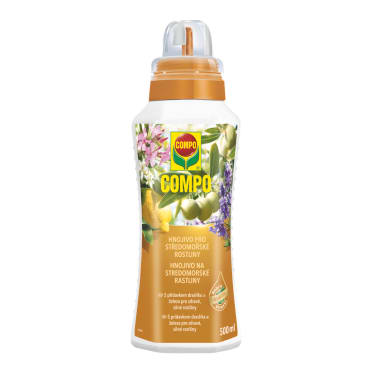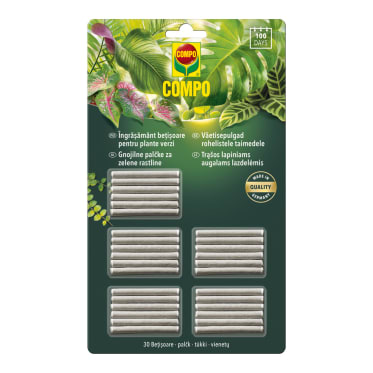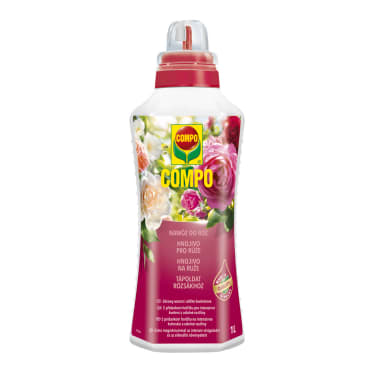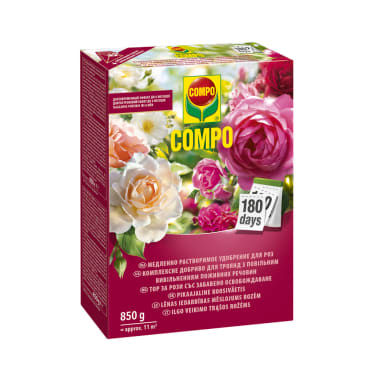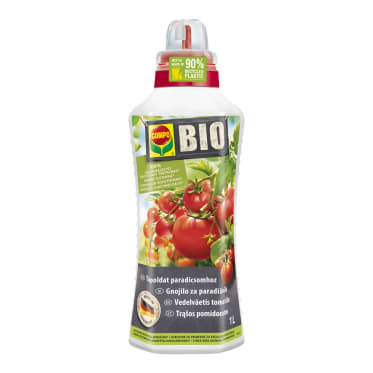Frequent search terms

- COMPO
- Guide
- Plant Care
- Basics
- Fertilisers and plant protection
- Fertilising plants – the bumper fertiliser special
Fertilising plants – the bumper fertiliser special
Mineral fertilisers, organic rose fertilisers, special fertilisers for hydrangeas – when you wander through the garden centre, you can't help but wonder what these supplementary fertilisers are for. Aren't compost or coffee grounds enough? And what do 'organic' and 'mineral' mean? To create some clarity here, we'll show you which nutrients plants need and what kinds of fertiliser there are.
Table of content
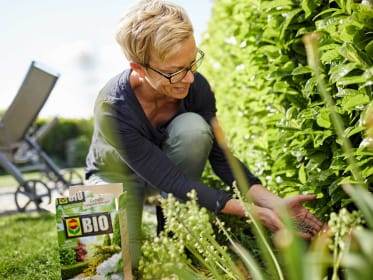
What does fertiliser mean?
By 'fertiliser', we mean everything used to give plants additional nutrients. Alongside water, air and sunlight, garden plants and balcony plants alike need all kinds of extra nutrients from the soil so they can grow and form flowers and fruit. Fertiliser can be applied in the form of organic material like compost, bark humus, or horse manure, or in mineral form as artificial fertiliser.
Why plants need fertiliser
Nothing is possible without nutrients – that goes for both humans and plants alike. In nature, dead plant parts and dead animals are broken down by organisms in the soil. In turn, this releases nutrients that plants can absorb.
However, plants living in containers on your patio and balcony only have access to a minimal amount of natural, organic material. In the garden, too, plants draw important nutrients from the soil that they need to form leaves and flowers as time goes on. These nutrients only return to the biogeochemical cycle when the plant sheds its leaves or dies in the autumn. If you remove grass clippings, brushwood, leaves or dead parts of plants, you're taking the nutrients out of the biogeochemical cycle. However, simply fertilising with leaves or grass clippings would be too one-sided, as these raw materials are rich in nitrogen but low in other nutrients. In other words, they couldn't cover the full range of nutrient needs.
So, if you'd like healthy plants bursting with life, you need to make sure you're fertilising in a balanced way. The same applies as with our own nutrition. All nutrients need to be present in adequate quantities for optimal development. One nutrient cannot be replaced by another.
What nutrients do plants need to grow?
Nitrogen is one of the most important nutrients. It's a fundamental building-block for various amino acids, nucleic acids and enzymes, while also being involved in photosynthesis. Relatively large quantities of nitrogen are needed, which is why it's called a primary nutrient or a macronutrient. Phosphorus and potassium are other key primary nutrients. Magnesium, sulphur and calcium round off the list of macronutrients and are also termed 'secondary nutrients'.
Alongside the six macronutrients, there are also micronutrients. These trace elements are plant nutrients that are important for the plant, albeit in smaller quantities. From a scientific perspective, there are eight micronutrients: iron, zinc, manganese, nickel, molybdenum, chlorine, boron and copper. Each of them is crucially important for at least one role within the plant and cannot be replaced by a different nutrient.
Last but not least, there are also useful elements that support plant development but don't cause the plant to die if they're in short supply. They include sodium, selenium and silicon, for instance.
|
Primary nutrient |
Functions |
Symptoms of a deficiency |
|
Nitrogen (N) |
Involved in various metabolic processes; ensures vegetation growth |
Symptoms of a deficiency: stunted growth, yellow leaves, brown tips of leaves, parts of the plant dying |
|
Phosphorus (P) |
Supports the formation of fruit and flowers, ensures good root development, boosts the plant's immune system |
Symptoms of a deficiency: distorted growth, weak roots, lack of flowers, reddish areas on leaves, reduced frost tolerance |
|
Potassium (K) |
Involved in the formation of plant tissue and various metabolic processes, boosts plants' resistance to frost, heat and pests, improves water balance, creates a more intense aroma for fruits |
Symptoms of a deficiency: split and discoloured fruits, reduced frost tolerance, higher susceptibility to diseases, e.g. leaf blight and late blight for tomatoes |
|
Magnesium (Mg) |
Important for phosphorus absorption, involved in the formation of chlorophyll, creates lush green leaves, boosts vegetation growth, ensures an intense aroma for fruits |
Symptoms of a deficiency: light patches on leaves, yellowed leaves, leaves falling off |
|
Calcium (Ca) |
Boosts the rigidity of tissue, ensures stable cell walls, boosts the plant's ability to withstand stress. |
Symptoms of a deficiency: flowers with a distorted appearance, brown dents/patches on fruits (blossom end rot)
|
|
Sulphur (S) |
Involved in enzyme formation, protein metabolism and plant growth; important for the use of nitrogen; boosts resilience; crucial for fruit aroma |
Symptoms of a deficiency: pale leaves, yellowing leaf veins, sluggish growth |
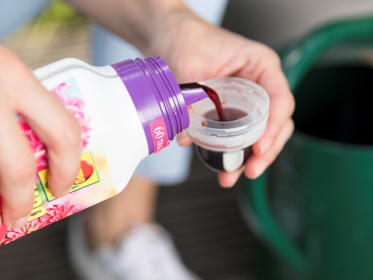
Discovered a nutrient deficiency? – This helps!
Is your plant growing in a distorted way or does it have yellow leaves? Then a nutrient deficiency is generally the cause. You can quickly combat this with the right fertiliser. If you often forget to fertilise your plants, you can use a slow-release fertiliser. Some slow-release fertilisers keep releasing fertiliser for up to six months.
Fertiliser sticks are also a handy option, be it for indoor houseplants or on the balcony. Simply put these sticks in the soil and they'll release nutrients for the plant over the course of two to three months.
That said, a nutrient deficiency isn't always necessarily due to low nutrient uptake. For instance, many garden soils contain phosphorus. However, the amount of phosphorus absorbed depends on the soil quality. It's plausible that a damp or dense soil with a low pH offers poor conditions for a good supply of phosphate. It would be counter-productive to try to combat this with phosphate-heavy fertilisers. Instead, it helps to break up the soil, enrich it with humus and add lime to it. You're best off performing a soil analysis in your garden and measuring the pH before you run the risk of over-fertilising it.
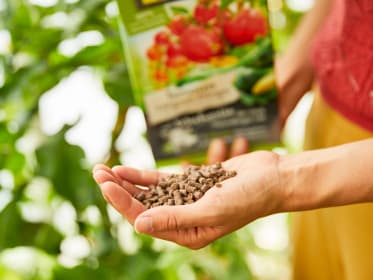
Differences between plant fertilisers
Plant fertilisers can differ in terms of form, production or content. For instance, there are solid fertilisers that are applied as pellets or fertiliser grains, and liquid fertilisers that you add to the water you're giving to the plants.
Besides this, a distinction can be made between fast-acting instant fertilisers and slower-acting slow-release fertilisers: while one gives its nutrients to the plants immediately, the other releases them gradually. Slow-release fertilisers are particularly useful for your main round of fertilisation in spring, while fast-acting instant fertilisers are popular if there are signs of an acute lack of nutrients – especially if the right time of year to use a slow-release fertiliser has passed.

Mineral or organic fertilisers
Fertilisers also differ in terms of their chemical compounds. In this respect, you can draw a distinction between mineral and organic fertilisers and the mixed variety:
1. Organic fertilisers
Organic fertilisers consist of plant-based or animal-based materials such as cocoa husks, grape seed waste, bone meal, horse manure, bone shavings or sugarcane molasses. Many organic fertilisers are sold as handy pellets, while others come in liquid form. For example, 'COMPO BIO Universal Longterm Fertilizer with Sheep Wool' is a natural fertiliser in the form of handy pellets.
Once the fertiliser has been worked into the soil, microorganisms break down the organic materials. In turn, they release nutrients, which are now available to the plants. This conversion of organic materials into nutrients that plants can access is a slow, conservative and natural process also known as mineralisation. This activates soil life and encourages humus formation.
NB: The soil needs to be suitably damp and warm so the microorganisms can get to work. In other words, the microorganisms will be inactive if the soil has dried out. On hot days, in particular, you need to make sure the soil is damp and water it generously. In addition, organic fertilisers should not be used if it's too cold and soil organisms aren't active. Depending on the weather, the perfect period for using organic fertilisers runs from March to November, or thereabouts.
Organic fertilisers are often available as slow-release fertilisers that continuously release their nutrients over several months so plants can access them over a longer period of time.

2. Organic-mineral fertilisers
Many organic materials such as horn shavings or bone meal are primarily known as nitrogen fertilisers. Organic fertilisers are enriched with other nutrients so that plants can continue to be supplied with all important nutrients. The result is an organic-mineral fertiliser. In this respect, some mineral fertiliser components, such as calcium or sulphur, are available in nature and do not need to be processed further. Consequently, many organic-mineral fertilisers are made of 100% natural ingredients.
3. Mineral fertilisers
Mineral fertilisers contain nutrients in the form of mineral salts. The nutrients are bonded to the salts in precise quantities, which makes them instantly available to plants. The salts dissolve into the soil moisture so that the plants can access the nutrients directly. As a result, mineral fertilisers are particularly swift suppliers of energy that can be perfectly adapted to plant needs. 'COMPO Liquid Fertilizer for Roses' is an example of a speciality mineral fertiliser. This liquid fertiliser is perfectly aligned with the nutrient needs of roses.
Alongside instant mineral fertilisers, there are also slow-release mineral fertilisers. They continually release their nutrients in harmony with the natural growth factors of warmth and water over an extended period of time (generally three to six months). An example of this is 'COMPO Slow Release Fertilizer for Roses', which has a long-term effect lasting up to six months.
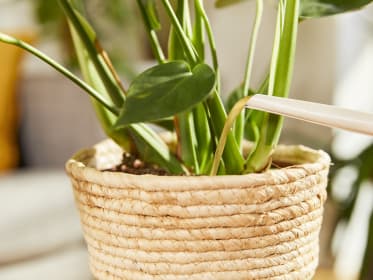
Single nutrient or multi-nutrient fertiliser
Many fertilisers contain two or more nutrients. These fertilisers are termed multi-nutrient fertilisers. Many of them are full-spectrum fertilisers, also known as NPK fertilisers. This means they contain the three most important nutrients for plants – nitrogen (N), phosphorus (P) and potassium (K). Some of them are also enriched with other macronutrients or trace nutrients.
'COMPO Liquid Fertilizer for Green Plants and Palms', for instance, is an NPK fertiliser that contains all the key macronutrients and trace elements, too. As a result, it means you can rest easy that all flowering and green plants have what they need. Plus, there are two-nutrient fertilisers, which only contain nitrogen and potassium, for example.

Universal fertiliser or speciality fertiliser
In general, most plant species growing in your garden need the same nutrients, and some of them need them in the same quantities, too. As a result, you can use a traditional universal fertiliser.
For some plants, though, speciality fertilisers are a good bet. For instance, tomatoes and other heavy-feeding fruiting vegetables need a large volume of nitrogen, potassium and calcium. Bog-soil plants like blueberries, rhododendron or hydrangeas, conversely, don't cope well with additional calcium – even watering them with hard tap water can harm them in the long term. As a result, giving them a special, calcium-heavy fertiliser would not do them any good.
If you'd like pretty flowers, an abundant harvest and plants living to a ripe old age, you should use plant fertilisers recommended for the variety in question.
When is the best time to fertilise?
One key principle is to only fertilise during the growth and flowering phase. If plants are in their dormancy phase or just about to start it, fertilising them isn't recommended. Many plants continuously generate new shoots if they're continually being given fertiliser. However, these new shoots stop hardening up properly, which means they're particularly sensitive to frost.
As a result, you should stop giving high-nitrogen fertiliser in mid-August at the latest, regardless of the variety of plant at hand. For shrubs, bushes and other perennial plants, you can use a high-potassium autumn fertiliser. Potassium ensures stable, thicker cell walls and protects plants from heavy frosts better as a result.
Note that for winter-flowering plants like Christmas rose or winter violet, you still need to fertilise with nitrogen, even in the colder months. After all, these plants are in their flowering and growth phases over winter.
How do I use fertiliser?
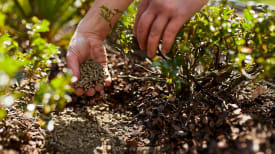
1
Solid fertilisers
Soil fertilisers or solid fertilisers are often worked onto or into the soil. These solid fertilisers are available as pellets or handy fertiliser sticks, for instance. Distribute the fertiliser as evenly as possible over the soil, then water well.
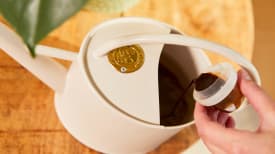
2
Liquid fertilisers
You should shake liquid fertilisers before using them, then add them to the water used for watering. Fertiliser soaks into the soil particularly well if the soil is already slightly damp. It's harder for nutrients to be absorbed on dry soil.
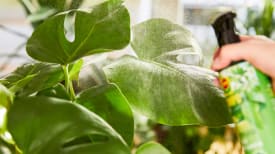
3
Leaf fertilisers
Leaf fertiliser is sprayed onto the leaves so they can absorb the nutrients. These leaf fertilisers are particularly popular for house plants, as the nutrients have a direct impact on the leaves and ensure they're a lush green colour. When using a leaf care spray, the leaves should be dry so it's not diluted. Plus, you shouldn't spray during full sun to avoid scorching.
Five tips for fertilisers
The following five tips help you fertilise plants properly so they can absorb nutrients well:
- Choose a still, cloudy and dry day to apply the fertiliser.
- If the soil is already very dry because it hasn't rained for a while, water the beds before fertilising.
- Water generously after fertiliser application. When using liquid fertiliser, the fertiliser is applied with the water you're using to water the plants.
- The best time of day is early morning or early evening.
- Don't fertilise over lunchtime when the sun is particularly strong.
How often should you fertilise plants?
In general, solid fertiliser can be added into the planting hole or worked into the soil for your main annual round of fertilisation in spring. Liquid fertilisers are ideal if you want to give plants a fertiliser top-up during the garden season.
Depending on the plant variety and need, you can do this at various intervals, from twice a week to once a month. In turn, heavy-feeding vegetables, like tomatoes or watermelons, need substantially more nutrients than medium or light-feeders like carrots, radishes or basil.
Alternatives: coffee grounds as a fertiliser?
Coffee grounds and eggshells do actually contain various nutrients. However, if you only use coffee grounds as your fertiliser, there's the risk that the plant won't get everything it needs. That's because coffee grounds contain lots of nitrogen but hardly any potassium or phosphorus. Eggshells primarily contain calcium. So, if you own lime-loving plants, you can work the remains of your breakfast egg into the soil without causing any issues. That said, neither alternative is an ideal choice when it comes to providing balanced nutrition. Some plants are even sensitive to over-fertilisation with lime (calcium) or nitrogen. So, we don't recommend putting your morning coffee grounds into your houseplants.
A third alternative is compost. If you compost vegetable waste, leaves or grass clippings, you can use the resulting compost as a basic fertiliser for your garden plants. Compost can improve the soil structure and ensure an active soil life. The proportion of nutrients can vary depending on the components that make up the compost. If, for instance, your compost includes grass clippings from your garden, it will generally contain fewer nutrients than compost made from organic waste. Usually, though, the proportion of nutrients available to plants is small. Heavy-feeders, in particular, need substantially more nutrients. Some plants, like rhododendrons or hydrangeas, that like an acidic, low-lime soil, don't cope well with compost fertilisation as this usually raises the pH.
In other words, compost is a fantastic supplement and a great way to improve the soil – but it doesn't normally replace a balanced supply of nutrients.
Which fertiliser for which plant?
As you've learned in the previous sections, there's an array of different fertilisers. So you can pick up the right product when you next walk through the garden centre or DIY store, we've put together a brief overview of the fertilisers for different plants.
Brief overview of plant fertilisers
These topics may also interest you






